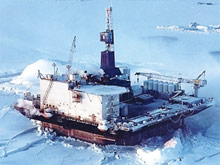Nearly a quarter of the world's undiscovered petroleum resources lie in the Arctic, confirms a U.S. study that should only intensify pressure on countries such as Canada to stake their claims to the Far North.
The U.S. Geological Survey has previously offered a rough estimate of the Arctic's vast oil and gas resources. On Wednesday, the federally-funded agency released a study that refines its estimates for the entire Arctic region.
According to the new assessment, the Arctic holds an estimated 90 billion barrels of undiscovered oil. That accounts for 13 per cent of the world's total undiscovered reserves. By comparison, the Alberta oil sands are estimated to hold about 173 billion barrels that can be extracted economically.
The Arctic actually appears to be far richer in natural gas than oil. There are about 1,670 trillion cubic feet of natural gas in the Arctic, according to the U.S. assessment. That accounts for about 30 per cent of the world's untapped reserves, and is nearly as much as the proven reserves of the world's most natural-gas endowed country, Russia. Combined, oil and gas account for 22 per cent of the world's undiscovered petroleum resources.
"For a number of reasons, the possibility of oil and gas exploration in the Arctic has become a subject that's much less hypothetical than it once was," said U.S. Geological Survey geologist Don Gautier.
The new assessment comes as Canada jockeys with other Arctic nations to determine how far their national boundaries extend - and who will cash in on the oil and gas that experts expect to become increasingly enticing as climate change accelerates the rate of ice melt.
In a summary of the results, the U.S. Geological Survey says the "extensive Arctic continental shelves may constitute the geographically largest unexplored prospective area for petroleum remaining on Earth."
Under a U.N. treaty called the Convention on the Law of the Sea, countries can claim offshore territory to the edge of their continental shelf.
Canadian scientists have been mapping the seabed in preparation for Canada's claim, which must be submitted by 2013.
Some of the oil and gas deposits are believed to be located in territory under dispute between Canada and its Arctic neighbours.
For example, Canada and the United States disagree over who controls a portion of the Beaufort Sea. According to the new estimate, the biggest undiscovered Arctic oil reserves are off the coast of Alaska.
Imperial Oil, a subsidiary of energy giant Exxon Mobil, has earmarked more than half a billion dollars to explore for offshore petroleum in the Beaufort Sea, and the federal government recently closed a call for bids to explore five more offshore parcels.
Another big potential source of oil and gas are the waters between Greenland and the northeast Canadian Arctic. However, Canada and Denmark have clashed over control of Hans Island, a speck on the map between Greenland and Ellesmere Island.
Because conventional seismic and drilling data is not available, the U.S. Geological Survey used a probability model based on factors such the composition and age of rock samples.
The assessment measures only reserves that are "technically recoverable."
Industry experts believe the price of oil and gas would have to increase considerably before it would be cost-effective to recover much of the Arctic reserves - 84 per cent of which are offshore, according to the assessment.

